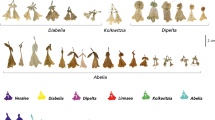Abstract
Eucalyptus is recognised as containing somewhat more than 450 species, but this number could reasonably be either decreased or increased considerably by slight variations of species concept. Recognition of taxa, at least in the wild, is less difficult than supposed but their ranking depends on degree and nature of discontinuities or steepened gradients of correlated variation, in this group of diploid sexual outbreeding trees of the dominant stratum. Some 8–10 rather distinct lines marked by different character constellations are discernible inEucalyptus s. lat. (incl.Angophora), and it is clear that the floral operculum is of diverse nature and multiple origin. The advisability of recognising several distinct genera depends on the wideness of polyphylesis in relation to other Myrtaceous genera, and (unfortunately) on practical convenience.
Similar content being viewed by others
References
Bentham, G., 1867: Flora australiensis, Vol. 3. London: Reeve.
Blakely, W. F., 1934: A Key to the Eucalypts, 1. ed. Sydney: The Worker Trustees.
—, 1965: A Key to the Eucalypts, 3. ed. Canberra: Commonwealth of Australia Forestry and Timber Bureau.
Carr, S. G. M., andCarr, D. J., 1963: The taxonomic position of certain eucalypts. Proc. Roy. Soc. Victoria77, 207–216.
—, —, andRoss, F. L., 1971: Male flowers inEucalyptus. Aust. J. Bot.19, 73–83.
Dawson, J. W., 1970: Pacific capsular Myrtaceae. I. Reproductive morphology ofArillastrum gummiferum Panch. exBaillon (New Caledonia). Blumea18, 431–440.
Johnson, L. A. S., 1972: Evolution and classification inEucalyptus. Proc. Linn. Soc. N. S. W.97, 11–29.
—, andBriggs, B. G., 1975: On theProteaceae—the evolution and classification of a southern family. Bot. J. Linn. Soc.70, 83–182.
Pryor, L. D., andJohnson, L. A. S., 1971: A Classification of the Eucalypts. Canberra: Australian National University.
Schmid, R., 1972: A resolution of theEugenia-Syzygium controversy (Myrtaceae). Am. J. Bot.59, 423–436.
Troll, W., 1964: Die Infloreszenzen, Band 1. Stuttgart: Gustav Fischer.
Author information
Authors and Affiliations
Rights and permissions
About this article
Cite this article
Johnson, L.A.S. Problems of species and genera inEucalyptus (Myrtaceae). Pl Syst Evol 125, 155–167 (1976). https://doi.org/10.1007/BF00986148
Received:
Issue Date:
DOI: https://doi.org/10.1007/BF00986148




